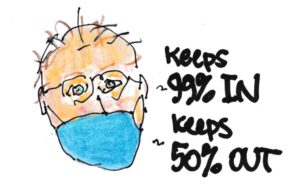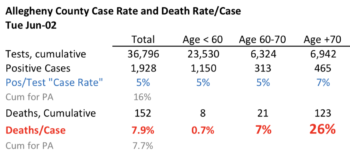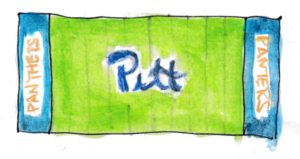How will you control your risk of getting COVID-19 (and dying)?
Posted on June 3, 2020

We all make personal decisions about risk every day. Driving is a risk. Walking on an uneven sidewalk is a risk that I pay attention to. You’ve already made decisions that decide the financial risk of your retirement plan. You’ve decided – with or without logic and thought – the three things that set risk: your spending rate; your mix of stock and bonds; and how much you choose to pay the financial industry. But our daily risks and our financial risk pale relative to the risk of getting COVID-19, and – if you are a certain age – dying from IT. This post summaries two very good articles that helped clarify my actions to sharply lower our risks UNTIL VACCINE.

== Three excellent articles ==
I mentioned the first article I list below in my May 1 post. This post has a summary of the latter two that you can download here. The remaining text of this post is my summary of the summary!
Coronavirus: Learning How to Dance. Tomas Pueyo. April 20.
The Risks – Know Them – Avoid Them. Erin Bromage. May 6 and 20.
Amid the Coronavirus, A Regimen for Reentry. Lessons learned from the way hospitals are preventing coronavirus in their employees and patients. Atul Gawande. May 13
== My summary of the summary ==
Most all transmissions of infections are from family members: one member gets IT in the community and then infects other family members. How do you and your family members avoid getting IT in the community?
You must acquire an infectious dose to become infected. Successful infection = intake of an infectious dose = about 1000 viral particles. Example: Infectious dose that you breathe in = Viral Load in air x Time you are breathing IT in – the number of breaths it takes to suck in a viral load.

The most infectious period is BEFORE someone has symptoms. This is not unlike normal, seasonal flu, except most think those with COVID-19 are more infectious before symptom than than those with seasonal flu. People are out and about who feel fine or maybe a bit peaked, but they are highly contagious. They sneeze, cough, or breathe out respiratory droplets that you then breathe. They sneeze or cough and get respiratory droplets on their hands and then they touch something else, depositing virus there.
You basically have to breathe IT in to get IT. This accounts for maybe 94% of all transmissions.

Your WORST RISK would be, without a mask on, to breathe in some of the near-by sneeze cloud of an infectious person. Your one breath = infectious dose. Just as bad: accumulate 1,000 viral particles from touching an elevator button or door handle several times and then rub your eyes or nose. A single cough can be bad. But it’s much longer exposure – many more breaths – in other cases. Less than 15 minutes spent with an infected person – with no sneeze or cough – means low chance of transmission. Out of 445 traced contacts within six feet and 10 minutes or more with an infectious person, only two became infected and both had had an infected person in their household.
Touching something with enough virus on it and then touching your eyes, nose or mouth is much lower risk of getting an infectious dose. The CDC says it’s hard to get IT this way. Don’t ignore this risk, and wash your hands often. But put this risk in perspective.
Your mask protects others; it blocks perhaps 99% of your exhaled respiratory droplets so they don’t get an infectious dose if you have IT. Your mask also protects you; it blocks perhaps 50% of inhalation of respiratory droplets.

The viral load in air is dispersed and diluted with greater distance distance from an infected person and with air circulation. Six feet is a good physical distance, but it’s a choice guided by practicality. A forceful sneeze (no mask) can propel respiratory droplets 20 feet.
Masks + distance + big open spaces + short time exposure = very low chance of breathing in viral load. What’s this mean?
Smaller indoor spaces are highest risk. Too little air volume and possibly poor air circulation. Small respiratory droplets hang in the air. Your risk of an infectious dose increases 1) as the size of space decreases; 2) as the number of people increase; 3) as their activity increases with no masks: breathing quietly; speaking, speaking loudly; shouting; yelling; 4) as your time of exposure increases.
The conclusions for Patti and me are similar to those I stated in the prior post. We say NO to dine-in restaurants. NO to airplanes. NO to indoor social gatherings.

Outdoors and outdoor activities are lowest risk accounting for perhaps 0.3% of transmissions. Infinite air volume and mixing means the viral load is very small. So far, almost people we encounter when we are out walking wear a mask or pull it up when they get near us. Those who are not wearing a mask give way to those wearing a mask – they make sure the distance is much more than six feet. Joggers really go the extra distance to stay away. But the risk is tiny even if you pass someone within six feet who is not considerate enough to wear a mask. The contact time is fleeting.
I still say NO to outdoor crowds; I can’t count on all wearing a mask. Crowds I like will be shouting and yelling: that means no Pitt football or basketball games. I’ll miss them!

The risk is small in stores with big air space. For Patti and me those safer spaces are the grocery and the nearby Home Depot. The air volume is large; all customers and staff wear masks; the stores we go to limit the number of shoppers; we can figure out the times when they are not crowded; shoppers are very good about sticking to the six feet rule; we’re not there long.
Rules and culture are important. New York has lower percentage of cases for hospital workers than the general public. Hospitals follow rules that we can follow:
• Know the symptoms and stay home if you experience any of them; immediately throw away whatever you sneeze or cough into and wash or sanitize your hands; don’t give it by touching something with your virus-laden hands.
• ALWAYS wear a mask indoors. All others in the store should be wearing a mask.
• Keep the six-foot rule, especially indoors. Mask + six feet + short time exposure + big air space = really low risk.
• Hygiene: before you go into and as you leave a group or store, wash or sanitize your hands.
• Culture: hospitals have created a culture of not being the one to infect another. It’s the culture of a hospital operating room. It’s a disgrace if you give IT to someone else.
We each can do our part on reinforcing the proper culture. We need to reinforce use of masks, distancing and hygiene. We should be examples of doing the right things. Here are my thoughts.
I will focus on stores that fail to require masks for employees or customers and fail to enforce the six feet rule. I’ll complain to management and refuse to shop there in the future.
I will always wear my mask indoors. That’s a requirement here. I hope it remains. Some areas of the US just suggest use of masks indoors. That’s CRAZY!
I now have less concern about others outdoors. I always have my mask with me, but I’m not comfortable wearing a mask 100% of the time when Patti and I are out walking, especially up the hills here. I typically have it half on, mostly under my chin. I will always put it on or pull up my mask if I walk by someone outside. But after reading the information in the articles, I’m less upset with folks out walking or jogging with no mask. I will assume those not wearing a mask will give us a wide berth; if they don’t, we move – even to walk in the street. But I’m not going to call them out unless I judge them as purposely inconsiderate.
Conclusion: We all need to know how to minimize the risks of COVID. This post summarized two excellent articles. I conclude you basically have to breathe IT in to get IT. Masks + Distance + Short Exposure Time greatly lower risk. I’ll wash my hands like crazy, too. We all need to be examples that others see to reinforce a culture of not infecting others. Number one in my book is always having my mask on when I might come within six feet of someone.